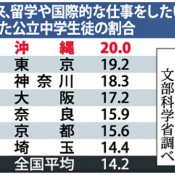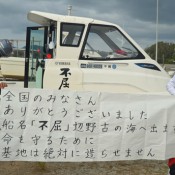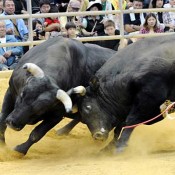Top News

November 19, 2014 Ryukyu Shimpo
Amid a water shortage in the Yaeyama region, which has been experiencing low rainfall, rain-making rituals were held for the first time in about 25 years on Kohama Island. When seven Kantsukasa (woman priests) started to sing a song calling for rain, a light rain began to fall. Smiles spread on the faces of villagers who watched the priests with a feeling of hope.
Kantsukasa priests prayed to Gandoura thunderstones, which were placed in a Kabone sacred site, asking for them to bring rain. After that, young men brought the thunderstones to the center of the island and played a traditional game using the stones. Gandoura stones have been used in rain-making rituals since early times on the island. They create a sound like thunder rumbling when they fall on the ground. It is said that the sound calls on thunder to bring rain.

<em>Kantsukasa</em> (woman priests) prayed to Gandoura thunderstones on November 18, on Kohama Island, Taketomi.
Then, the priests sang songs and prayed with words to call rain.
Toru Urasoko, director of the Kohama Community Center, said, “We do not have enough rain. Sugarcane crops are withering, resulting in a serious situation. We want our prayers to reach heaven. “The community will continue to hold rain-making rituals if the rain does not fall.
(English translation by T&CT)
Go to Japanese
November 12, 2014 Ryukyu Shimpo
Expenses related to a plan to build an alternative facility to Futenma Air Station in Nago, covering the period from May 1, 2006 to November 5, 2014 amount to 40,860,000,000 yen. The U.S. and Japanese government reached an agreement on the Realignment of U.S. Forces in May 2006, which included the plan to relocate the air base.
On November 11, Mizuho Fukushima, an upper house member, received an answer from the Japanese government to her inquiry regarding the expenses.
The total cost so far is broken down over the nine years as follows; expenses amounted to 3,030,000,000 yen in the fiscal 2006, 5,120,000,000 yen in the fiscal 2007, 8,650,000,000 yen in the fiscal 2008, 1,190,000,000 yen in the fiscal 2009, 1,110,000,000 yen in the fiscal 2010,5,010,000,000 yen in the fiscal 2011, 5,420,000,000 yen in the fiscal 2012, and 4,200,000,000 yen in the fiscal 2013, and 7,120,000,000 yen in the fiscal 2014.
In the fiscal year of 2014, the government has already spent 180,000,000 yen from a discretionary reserve to set up buoys off the coast of Camp Schwab.
The Japan Coast Guard has enhanced security on waters off the Henoko district of Nago, using a “dangerous situation” clause, stipulated in article 1 of provision 18 in the agency’s regulation, for the first time. The article states, “We determine dangerous situations are being caused by natural or anthropogenic factors from an objective viewpoint, or it is highly possible that we will see these situations occur.”
(English translation by T&CT)
Go to Japanese
November 18, 2014 Ryukyu Shimpo
On November 17, Yonaguni Town Council passed a referendum ordinance asking residents if they accept the deployment of the Japanese Ground Self-Defense Force to Yonaguni Island. The council voted 3-to-2 in favor of having a referendum. The Ministry of Defense plans to place a coastal monitoring unit on the island. However, Town Mayor Shukichi Hokama showed his opposition in calling the referendum, suggesting that the plan should be scrapped.
It is not yet clear whether the referendum will be held.
According to the Local Government Act, if the head of the local government objects to the decision of the council, he or she may submit a resolution for reconsideration. The mayor said, “I want to scrutinize the contents of the referendum ordinance. In some cases, I will subject it to reconsideration.” The council requires two thirds of its members or more, including the chairman, in order to pass the referendum proposal returned by the mayor.
The referendum proposal will likely be rejected because the town council consists ofthree members of the ruling party and three of the opposition party.
The proposal ordinance provides that; the voting age is a first-grade student of junior high school age (12-years-old) or older, and the mayor must carry out the referendum 60 days from the effective date. The mayor must also strive to realize the will of the residents reflected in the referendum, consulting with the government and its relevant agencies.
(English translation by T&CT)
Go to Japanese

November 12, 2014 Ryukyu Shimpo
At a busy intersection on National Route 58 in Urasoe, a kitten about 20 centimeters long was saved by firefighters after getting stuck under a mini-van at a red light. The incident occurred at Jitchaku intersection on November 11.
Hideo Akamine, who was driving the van, said smiling, “I think it was destiny for me to meet the kitten, which might usher in good fortune.” Akamine has taken the cat under his care.
When Akamine was waiting for the traffic light to change, a truck driver in the next lane spotted the kitten sitting on its haunches on the road. The driver jumped out of his car and quickly told Akamine about the kitten when he was about to hit the accelerator, as the light had turned green.
Akamine’s van nearly hit the cat but stopped just in time. Akamine and the truck driver peered into the kitten. Then the cat escaped into the back of a tire.

The rescued kitten is fortunate to be in the care of a new owner. Around Jitchaku intersection in Urasoe around 11 a.m. on November 11(Photograph taken by Futoshi Hanashiro).
They were caught in the middle of a major intersection heavy with traffic, but Akamine could not move the van or he might have run over the cat. One of the people at the scene called the Urasoe Fire Station and firefighters came to the rescue.
The firefighters confirmed that the kitten was stuck inside the mechanics of the van. They then carefully moved the van to a safe spot.
Within five minutes, one of the firefighters had crawled under the car, and saved the cat, which was clinging hard onto the internal part of the van.
Akamine, who is the head of an institution supporting disabled people, said, “The members of our institution will be happy to have the kitten because they have been missing a neighborhood cat which they previously took care of.”
The kitten, having narrowly escaped being badly injured or killed by the van, is now fortunately in the care of its new owner.
(English translation by T&CT)
Go to Japanese

November 14, 2014 Yoshiki Nagahama of Ryukyu Shimpo
A nationwide survey on academic ability conducted by the Ministry of Education in 2013 revealed that 20 percent of students in public junior high schools in Okinawa answered “yes” to the question, “Do you think you are interested in studying abroad and/or having an international job experience in a future?” The ratio is the highest in the nation, and well above the national average, which was 14.2 percent. The survey results show that many students in Okinawa have a high level of interest in international experiences.
Tokyo ranked second with 19.2 per cent, followed by Kanagawa Prefecture with 18.3 percent. Four other prefectures, Osaka, Nara, Kyoto and Saitama, exceeded the national average. Prefectures that placed 8th to the 42nd were below the average, falling between 10 to 13 percent.
To the same question, 20 percent of students in Okinawa answered, “moderately agree,” which was also the highest percentage in the nation. The national average was 15.7 percent.
Executive Board Member of the Okinawa Prefecture Study Abroad Consortium Tadahiko Kinjo, who promotes Okinawa’s various study abroad support programs, said, “The intake number for applications for overseas study prefectural scholarships per head of population is the highest in Okinawa out of all of Japan. It is only Okinawa that has a subsidized system to assist all necessary costs for studying abroad for one whole year. Local municipalities also have unique programs.” Kinjo said, “Historically, Okinawa has openly welcomed different cultures. As a tourist destination, Okinawa must have a capacity to welcome and understand people from the outside.”
University of the Ryukyus Professor Munehiro Machida, who serves as an advisor for the Obuchi Program to support study abroad programs in Hawaii remarked, “It seems the number of students who take a leave of absence from college and go abroad for a trip or for study is increasing. In Okinawa’s case, I assume that having relatives overseas (due to immigration and other reasons) has made many people feel closer to foreign countries.”
Since the 2012 fiscal year, Okinawa has sent about 100 people including high school and university students to 20 countries, through a government-subsidized International Human Resource Development Project. The prefectural government subsidizes travel expenses, tuition fees, and health insurance.
(English translation by T&CT and Megumi Chibana)
Go to Japanese

November 15, 2014 Ryukyu Shimpo
On November 14, at Teima fishing port, Nago, a citizen group held a launching ceremony for a new ship, which they will use to protest against a landfill project being carried out to build a replacement facility for the U.S. Futenma base. The ship has capacity for ten people and is named Fukutsu (Invictus), in honour of a popular resistance activist and politician.
The Peace Research Institute of Okinawa has called for a nationwide fundraising campaign in order to buy a protest ship. Enough funds to buy the ship could be raised in about a month, it says. The ship’s name Fukutsu is a word that Kamejiro Senaga (June 10, 1907 – October 5, 2001) used in his calligraphic writing. The word is painted on the body of the ship, in the style of Senaga’s handwriting. Senaga was a Naha Mayor and a prominent political figure when Okinawa was under US governance. He was imprisoned by American military authorities. Later, he served as a member of the Japanese Diet, in the House of Representatives, before retiring from politics.
Captain Hajime Kanai, a pastor and a coordinator of the Peace Research Institute, said, “By inheriting Mr. Senaga’s spirit, we will resist bowing before any oppression. We will struggle against the government using this ship.”
Hiroshi Ashitomi, co-representative of the Helicopter Base Objection Association, said, “I would like this ship to be a pillar of struggle in Henoko.”
On the same day, about 60 people held a sit-in protest in front of Camp Schwab in Henoko. Gavan McCormack, an Emeritus Professor of the Australian National University, spoke to the people, “I would like to write about the meaning of this struggle. Now you are creating a new history. We will show our solidarity with you from abroad.”
(English translation by T&CT)
Go to Japanese

November 1, 2014 Ryukyu Shimpo
On October 29, an eight-year-old police dog Daniel and assistant police inspector Atsushi Urasaki were awarded by Naha Police Station. Daniel and his partner found a boy who went missing at the southern part of Okinawa Main Island on October 2. Naha Police received a request from parents saying that their boy did not show up at school after he had left home. Daniel and Urasaki searched the area around apartments and parking lots near his house, pursuing the scent from the missing boy’s cloth. They finally found the boy safe after 40 minutes of searching.
Daniel is an expert police dog that is 50 to 60-years-old in human years. The dog has a gentle nature and a sense of curiosity. Daniel has been trained in chasing suspects and recognizing his or her smell. Urasaki said, “We got a good result and will keep training together.”
(English translation by T&CT, Hitomi Shinzato)
Go to Japanese

November 11, 2014 Ryukyu Shimpo
Nineteen Japanese nature study societies, including the Ecological Society of Japan with 4,000 researchers, submitted a written request to the central government and Okinawa Prefectural Government on November 11. They seek to review the plan to build an alternative base in Henoko, Nago, for U.S. Marine Corp Air Station Futenma in Ginowan, and call for the cancellation of the construction. They also demand the government conduct another environmental impact assessment of the Henoko relocation plan.
Makoto Kato, chairman of the Nature Conservation Committee of the Ecological Society of Japan and a professor at the Graduate School of Kyoto University, Masanori Sato, chairman of the Nature Conservation Committee of the Japanese Association of Benthology and a professor at the Graduate School of Kagoshima University, and Masami Obuchi, a member of the Japanese Society of Systematic Zoology, visited the Okinawa Prefectural Government to hand their petition to the environment department’s officials. They handed it over on behalf of 19 institutions. It is rare for such a long list of signatories to make a joint statement to the central and local governments.
“More than five thousand species were confirmed in the water and land areas in the environmental assessment. After the assessment was made, new species and undescribed species have been found one after another. This fact is still generally unknown. We understand this matter [landfill] is a very troubling problem and this is an urgent situation. It is a global issue to preserve biodiversity,” Sato said at a press conference held after the request was made. He highlighted that the government should conduct strict assessment of Oura Bay, rivers and land to conserve the natural environment.
Kato stressed that the biodiversity of the sea, including the coral reef ecosystem, is something Japanese people can be proud of because Japan has few resources. He described Oura Bay as a “Japanese Treasure,” where biodiversity remains in particularly good condition on land and sea as one. “The Japanese government is taking the stupid action of destroying the world’s treasure by reclaiming the sea of Henoko. We can foresee the future of Okinawa in the fate of dugongs.”
They sent the written requests to the Ministry of Defense, the Okinawa Defense Bureau and the Ministry of the Environment by mail.
(English translation by T&CT)
Go to Japanese

November 10, 2014 Ryukyu Shimpo
On November 9, the 102nd All Okinawa Togyu (Bullfighting) Autumn Tournament was held, sponsored jointly by the Okinawa Prefectural Bullfighting Federation and the Ryukyu Shimpo Co., at the Ishikawa Multipurpose Dome in Uruma City.
Twenty-four bulls competed in 12 bouts.
About 4,500 people watched the event, cheering for the bulls and holding their breath at suspenseful moments in close bouts.
In the open-class championship, Toryuseigo defeated Ishizanharukao in a bout that lasted 18 seconds, thereby securing the title and becoming the strongest bull in Okinawa.
Tosho Hayate defended its seventh championship title in the middleweight division, weighing no more than 970 kilograms. Hayate defeated Sentoufunushi in a fierce bout that lasted 8 minutes and 51 seconds.
In the lightweight division of 850 kilograms or less, Musourabuoyakata returned to the throne, defeating Ryutenryuonimaru in a seesaw struggle that lasted 13 minutes and 47 seconds .
(English translation by T&CT)
Go to Japanese
November 7, 2014 Ryukyu Shimpo
On October 30, a marine barricaded himself with a rifle in housing area of Camp Lester in Chatan, setting off a standoff with military police. There is a high possibility the marine moved in the civilian district outside of the base, carrying an M-16 rifle.
Marine Corps officials explained to Chatan Town on November 5 the marine had brought the firearm from another base in Okinawa.
If military servicemen carry firearms off duty and walk around civilian districts, they will be investigated by Japanese judicial police and could be charged with a violation of the Firearm Control Law. However, the marine is in the custody of the U.S military as the standoff occurred within the base. It is unclear whether or not the Okinawa Prefectural Police can charge the marine with a violation of the Firearm Control Law.
According to Chatan Town, the marine brought the rifle from Camp Foster, and possibly went through the civilian district before coming back to Camp Lester. As of November 6, the U.S. military had not disclosed the details such as the gender of the marine. They stated that they were continuing to investigate how the marine got the firearm.
According to Ministry of Justice records regarding the jurisdiction of crimes committed by the U.S. military servicemen, Japanese judicial police officers are able to investigate cases that conflict with Japanese law regardless of the U.S. having the primary right to exercise jurisdiction.
Kazunori Inoue, the head of the Okinawa Defense Bureau, held a press conference in Kadena on November 6. Inoue said the bureau was investigating the possibility the marine went through a civilian district, carrying the firearm.
Chatan Mayor Masaharu Noguni said, “The incident could have brought great danger to the local citizens, depending on the mental condition and motivation of the marine. I am really worried about what happened because no details were disclosed. I would like the U.S military to disclose the information swiftly.”
Attorney Toshio Ikemiyagi who is knowledgeable about crimes committed by the U.S military servicemen, said, “There is a possibility the marine could have fired the rifle, killing or injuring local citizens. The Okinawa Prefectural Police should strongly urge the military to control this kind of case and explain the details of the incident.”
(English translation by T&CT)
Go to Japanese
November 17, 2014 Ryukyu Shimpo
Takeshi Onaga’s win in the Okinawa gubernatorial election has once again solidly demonstrated Okinawan people’s will against the construction of new U.S. base. The former Mayor of Naha Takeshi Onaga, 64, has re-stated his promise to oppose the plan to relocate U.S. Marine Corps Air Station Futenma to Henoko, Nago, where the governments of Japan and United States plan to build a new replacement offshore air base, after winning the Okinawa gubernatorial election. Onaga defeated incumbent Governor Hirokazu Nakaima, 75, who promoted the plan, with the backing of Prime Minister Shinzo Abe and his party. He also defeated another two independent candidates. Onaga won by a margin of about 100,000 votes. Through Onaga’s landslide victory, Okinawan people have demonstrated that they will decide what matters to them and make their own choices, and they have expressed their opposition to the construction of a new military base to the Japanese and U.S.governments.
We hope that Onaga will do his best to solve U.S.military base issues, including the Henoko relocation, by penetrating the Japanese government’s hard-line stance .
Okinawan people’s will must be respected
Forcing Okinawa, which hosts 74 percent of the U.S. military facilities in Japan, to accept a new base against its will, amounts to a denial of Okinawan people’s dignity. The Japanese government cannot be allowed to do this.
As a civilian movement enabled Okinawan people to win the election for the Chief Executive of the Government of the Ryukyu Islands under the U.S. military administration in 1968, this gubernatorial election asked whether or not Okinawan people would regain their dignity and pride.
Many Okinawan people felt Nakaima’s approval of the Henoko landfill hurt their dignity and pride.
The conservatives have split in this election, with Onaga opposing the Henoko relocation despite conservative support for it. This reflected the bi-partisan nature of the thoughts and feelings of a wide range of Okinawan people on the base issues.
This election is historically important because Okinawan people were determined to make a choice to regain their deteriorating morale and dignity.
The Japanese government clearly stated that they would carry out the Henoko landfill regardless of the election results. However, the Japanese government, which governs a democratic nation, is not allowed to do that.
Although the central government seems to think that Nakaima’s approval of the Henoko landfill gained agreement from the local citizens, it is wrong.
Nakaima became Okinawan governor by pledging to move the Futenma Air Station outside of Okinawa.
Okinawan people do not support the current governor’s switch to promoting the Henoko relocation.
Basically, most of the Okinawan people do not accept the Henoko relocation.
The Japanese government should sincerely accept the result of the gubernatorial election, in which the U.S. Marine Corps Air Station Futenma relocation issue was the major issue.
The Abe administration should give up the relocation plan, because it said it would work with Okinawan people. If the U.S government takes such a strong stance on democracy, it cannot ignore public opinion.
In the Nago Mayoral election, incumbent Susumu Inamine who pledged to prevent
the new base from being built in Henoko, was re-elected this January.
Nevertheless, the central government started forcing through the construction. It is clear that the government aimed to make Okinawan people feel powerless by making it seem as though the base’s construction was done deal to be taken for granted.
However, this failed to make Okinawan people shrink back.
It has further strengthened their position of opposing the construction of the new base.
It was made evident by the fact that many Okinawan people voted to refuse relocation of the base within the prefecture.
Support needed from Okinawan people
The U.S.military plans to build new helipads at Takae in Higashi Village in disregard of the opposition of the local residents.
As part of his strong stance against the deployment of the MV-22 Osprey to Okinawa, Onaga also opposes the construction of the helipads at Takae.
We would like Onaga to stop the construction. The 41 heads of the municipalities in Okinawa went to Tokyo and handed a petition to Abe requesting the easing of the base-hosting burden. They also demanded the U.S. and Japanese governments close and remove Futenma Air Station, and locate any replacement facility outside of Okinawa. The cancellation of the deployment of the Osprey to Okinawa was also requested in the petition. We would like Onaga to do his best to work on realizing what the petition demanded.
We now approach a critical stage of solving the base issues. In order to penetrate the Japanese government’s hard-line stance in forcing Okinawa to bear the burden of hosting the bulk of the U.S. military presence, Onaga needs further support from the Okinawan people. In working towards what the petition demanded, Okinawan people need to unite to appeal for co-operation on the base issues, and fully support Onaga.
There are many issues that need to be solved, other than the base issues.
Onaga plans to promote an independent economy based on peace including an economic strategy focusing on trade with Asian countries, increase regular employees, eliminate “childcare waiting lists” in certified day-care centers within four years, and make the cost of medical care free for children. Through these policies, Onaga aims to make Okinawan people’s lives more affluent.
We would like Onaga to implement his policy pledges by using the administrative skills that kept him in office as Naha Mayor for 14 years, and the political strength and leverage he has gained working in the Naha City Assembly and Okinawa Prefectural Assembly. Okinawan people want a peaceful and prosperous society.
We look forward to Onaga assuming the leadership role for the prefecture, as he faces the future with the Okinawa people, and works on the tasks entrusted to him.
(English translation by T&CT)
Go to Japanese









 Webcam(Kokusai Street)
Webcam(Kokusai Street)


